Scroll to:
DIGITAL TWINS AND THEIR APPLIANCE IN TRANSPORT ECONOMICS
https://doi.org/10.17747/2618-947X-2021-2-127-137
Abstract
Today digitalization increasingly affects the economy, including the transport industry. The consequence of this is the emergence of digital twins that allow modeling and predicting the behavior of both individual processes and enterprises as a whole.
The aim of the article is to investigate the process of digitalization in the transport industry. The theoretical basis of the article was the universal organizational science of A. Bogdanov.
The article offers a definition of information, and its classification in relation to the economy at three levels: applied information (technological information), information about algorithms of the owners of factors production behavior (behavioral information) and information, with which the impact on the owners of production factors and the real economy in general (directive information). The totality of these levels of information from the macroeconomic point of view forms an information economy, and from the microeconomic point of view – a digital twin of a particular subject of the real economy.
It is proved that the digital economy is a subsystem of the information economy, differs in a binary way of presenting information and is maximally oriented to the management of the real economy.
Information precedes all activity, so the real economy is a product of the information economy. Consequently, the technological division of labor is based on a prior informational division of labor. This theoretically allows us to judge the adequacy of the digital twin through the analysis of individual technological levels of the transport enterprise. This hypothesis was applied to the analysis of the Russian railway transport, which gave reason to consider this approach promising for use at macro- and micro-levels both.
Keywords
For citations:
Rimskaya O.N., Anokhov I.V. DIGITAL TWINS AND THEIR APPLIANCE IN TRANSPORT ECONOMICS. Strategic decisions and risk management. 2021;12(2):127-137. https://doi.org/10.17747/2618-947X-2021-2-127-137
-
INTRODUCTION
Significant progress in recent decades in the development of digital technologies and processing capacity of computers with a simultaneous reduction in the costs of their use has made digitalization a mass phenomenon that has affected all areas of the society and economy, whereas a digital twin has become an everyday reality.
The term “digital twin” became widespread after the publication of the article [Grieves, 2017] and today it is widespread in relation to virtual models of industrial objects or processes created with the help of information programs.
In our opinion, this term is applicable not only to technical systems, but also to economic ones, as the economy is increasingly becoming digital. In the railway industry, the first digital projects were created in the Soviet days at the Experimental Institute of Communications, the leading research institute of the railway industry (JSC VNIIZHT) [Mazo et al., 2021].
Digitalization has acquired both micro- and macroeconomic character. The Strategy for the Development of the Information Society of Russia until 2030 defines the digital economy as follows: “the digital economy is an economic activity in which the key production factors are digital data, the processing of large volumes and the use of analytical results which, compared to traditional forms of management, can significantly increase the efficiency of various types of production, technologies, equipment, storage, sale, delivery of goods and services1.
-
LITERATURE REVIEW
In a simplified form, the digital economy can be interpreted as “the economy of goods and services, the development, production, sale or supply of which is completely dependent on digital technologies” [Kling, Lamb, 2000], and its main distinguishing feature can be considered “the implementation of economic and social activities via the Internet » [Dahlman et al., 2016]. Indeed, “the interest in the impact of digital technologies on the economy initially arose with the growth of the Internet” [Foster, Azmeh, 2020. P. 1251]. However, in this respect, it is no longer possible to consider, for example, in-house information technologies that operate autonomously from the Internet (for example, software for a machine tool with numerical control) digital.
In this regard, some authors give a wider list of features of the digital economy, including cyber-physical systems [Barbosa et al., 2016], the Internet of things, digital twins, autonomous robots [Foster, Azmeh, 2020. P. 5-6]. Other authors believe that digital economy is also distinguished by specific products, as well as by new ways of production and consumer interaction, for example, in the shared use format [Daviesa et al., 2017].
In recent years, more and more attention has been paid to how digital technologies, services, products, methods and skills are becoming a key aspect of each sector, that is, digitalization, which is defined as “the transition of business to the use of digital technologies, products and services” [Brennen, Kreiss, 2016]. They facilitate the integration of firms into global networks with the participation of states [Sampath, 2018]. These kinds of digital platforms have indeed fundamentally changed the economic landscape, but they have also created a significant asymmetry between enterprises in the real economy and entities that own data and are able to use it (within and across countries) [Srnicek, 2016; Weber, 2017]. A fundamentally new feature of this increased organization is the ability to scale it to the whole world, as a result of which new players find themselves in a worse position than the pioneers [Zhu, Iansiti, 2012]. This explains the “winner takes it all” effects [Kuchinke, 2016] and the total dominance of companies like Amazon, Google, and Facebook. This means that digitalization can radically increase the level of internal organization of a subject, bringing it to a leadership position.
The advantages of the digital economy development according to the World Bank’s review "Digital Dividends"2:
- growth of labor productivity;
- increase of companies’ competitiveness;
- reduction of production costs;
- creation of new jobs;
- overcoming of poverty and social inequality.
Here one could add that in the digital economy, communication costs tend to zero and generate strong network effects [Engel, 2015]. In addition, “digitalization reduces transaction costs in order to combine human capital skills across geographic boundaries and increase the scalability of these skills” [Banalieva, Dhanaraj, 2019. P. 1379]. The scalability and speed of implementation of digital projects are also growing dramatically [Brouthers et al., 2016].
The introduction of digitalization into life in many sectors of the economy, in addition to obvious advantages, also brings a number of following disadvantages for the humanity:
- the risk of cyber threats associated with the problem of protecting personal data – the problem of fraud can be partially solved by introducing the so-called digital literacy;
- "digital slavery" – the use of data about millions of people to control their behavior, for example, to stimulate the growth of sales of goods and services due to massive online advertising;
- increased unemployment in the labor market, as the risk of the disappearance of certain professions and even industries will grow. Thus, many experts seriously believe that the banking system will disappear within the next ten years. This will become possible due to the further spread of information technology and its products: stores with electronic cash registers, customer service bots, unmanned vehicles, etc;
- “digital divide” – a gap in digital education, conditions of access to digital services and products, which leads to a gap in well-being of people living in one country or in different countries.
-
MATERIALS AND METHODS
Each collective subject acting in the economy, in terms of A.A. Bogdanov can be defined as an organized complex, understood by him as "the whole is greater than the sum of its parts".
Such an organized complex creates many different kinds of signals and simultaneously receives them from other subjects. For the transport industry, such signals can be the following: the demand for transportation services, the dynamics of production at key consignors, the state of infrastructure, macroeconomic conditions, changes in tax and credit rates, indexes of optimism of producers, population size, dynamics of final demand, energy supply of the country, etc. Some of these signals are external noise for the transport company, and the other part is recognized among this noise, embedded in cause-and-effect relationships known to the company; it changes its behavior and, as a result, becomes information. In other words, information in this article refers to external signals distinguished by an organized complex among the noise surrounding it and builds into its causal relationships, which allows to adapt its activity to a continuously changing external environment.
Sensitivity to external signals and the ability to distinguish them increase as the organizational structure of the subject develops and becomes more complex. In the course of this, information turns into a universal instrument of ingression (from Bogdanov’s point of view), that is, into a tool capable of connecting the activities of extremely diverse areas: the technosphere and human, technology and economics, natural and human sciences, etc.
However, for this, a certain category of signals from these areas must be singled out and brought to uniformity and a common understanding. Such signals in human civilization have become quantitative data, and the main way to recognize and understand them is mathematics, which, according to Bogdanov, is equally applicable “to combinations of astronomical worlds and biological cells, living people and ethereal waves, scientific ideas and atoms of energy” [Bogdanov, 1989. S. 124]. Indeed, mathematics is "defined as the 'science of quantities'. The value is the result of measurement; and the latter means the consistent application of some measure to the measured object and, obviously, proceeds from the prerequisite that the whole is equal to the sum of the parts” [Bogdanov, 1989. P. 124].
It also turned out that the operation of such mathematized, that is, impersonal and universally applicable information allows us to more fully identify causal relationships and use a fundamentally new opportunity: to model reality without the need to set matter and human being in motion each time, overcoming their inertia. For this, mankind in different periods of its existence used various material carriers: the human ability to remember (civilization of memory), available physical objects (wood, birch bark, clay, stone, bundles, etc.), (civilization of images), syllabic and alphabetic writing (civilization of letters), mathematical signs (civilization of numbers), binary signs (civilization of numbers)… Thus, mankind has constantly improved in the use of general, ingressive aspects of the processes and phenomena surrounding it, having achieved amazing success in this.
-
RESEARCH RESULTS
Any separate transport process can be understood as a process of connecting material objects (cargo, rolling stock, infrastructure, etc.) with energy, information and human labor. In this process, the information is applied as the application technology of such a connection and therefore it can be designated as the information of the first level (or application information).
With the accumulation of experience, the carrier, based on the information of the first level, receives the information of the second level (or behavioral information) in the form of understanding and preliminary modeling the behavior of those who own the following objects: cargo, infrastructure, labor, energy and information of the first level. These owners can be called the main subjects of the real economy.
Over time, it turned out that this information modeling system allows you to develop and apply your own tools for influencing the real economy, for example, in the form of a risk-sharing system for shippers, when trading caravans and ships were financed by several merchants together or, later, in the form of shareholding. The influence of such an information tool as money turned out to be the most global, which made it possible to minimize risks, time and transaction costs significantly, and build the longest possible production chains. Thus, it became possible not only to record and predict events and processes in the real economy, but also to determine them in many respects. This kind of digital signals can be called the third-level information (or deterministic, directive information). Such signals can be both formal and informal:
- cash and financial contracts;
- rights to resources,
- planning tasks, estimates, budgets, forecasts;
- equity participation rights;
- access to tangible and intangible objects;
- contracts for future deliveries, services and works;
- personal relationships, position in a small group;
- public reputation and position in the society, political weight.
Thus, with the help of the information, a person gradually received the following opportunities: modeling the combination of factors of production → modeling the behavior of the owners of these factors → predicting the reactions of the owners and controlling their behavior.
From this point of view, the information system in the economy is a system for fixing and processing quantitative signals from the subjects of the real economy, which has the ability to influence the behavior of these subjects with the help of reverse information signals.
If the information of the first level, in fact, is an algorithm for the interaction of subjects of the real economy in a particular situation, then the information signals of the third level launch these algorithms. This, among other things, means that the possibility of predicting and informational regulation of the behavior of subjects of the real economy is in harmony with their autonomy, since the reception of money and other signals actually launches a package of a predetermined algorithm of actions for a particular subject. An information signal is required only to change one algorithm to another, after which the subjects of the real economy act independently. Because of this, the third-level information can be used as flexibly as possible by combining such algorithms into long production chains.
Considering the above mentioned, the goal of the information economy is to increase the ideality of the real economy by eliminating various kinds of losses, risks and unproductive actions. To do this, each real production process is initially tested on information models. Based on the Pareto principle, we can say that the information economy is designed to help the real economy in performing only the productive 20% of activities while eliminating the remaining 80%.
Thanks to its unique advantages, the information economy is now able to manage the real economy, while the real economy cannot manage the information economy. This actually means that the information and real economies are related as a system and a subsystem. This is not accidental, since the state, science, education, upbringing, art and much more refer specifically to the information system.
However, today we see that an information system based on operating with numbers (0, 1, 2, ..., 9) is rapidly turning into a digital system using only two characters: 0 and 1. As a result of this process, for example, the value of a work of art, a movie, a video, a website, a scientific article, and much more today is measured by the number of views, comments, quotes, etc. It is noteworthy that the content of these views, comments, and quotes has ceased to have at least any meaning: a choice was made from two options (looked - did not look, read - did not read, quoted - did not quote, etc.). Thus, information now often turns into an alternation of the simplest and unambiguously interpreted states: yes – no, false – true, "+" and "-", "on" - "off", 0 - 1.
At the same time, the reverse movement of information – from the information system to the real economy – often takes on the same binary form: yes – no, perform – do not perform, permissible – unacceptable, impossible – possible, agreed – not agreed, etc. The same applies to assessments of the activities of the subjects of the real economy: good – bad, acceptable – unacceptable, to support the proposal – not to support, to allocate resources – not to allocate, etc. Having received this kind of binary information, the subjects of the real economy begin to perform one or another algorithm of actions pre-embedded in them.
From this point of view, digitalization is nothing more than a decrease in the sensitivity of the information system, an enlargement of the caliber of perceived signals and a unit of received and transmitted information. It also provides an increase in the stability of governance (just as a QR code is in some cases simpler and therefore more appropriate than an alphanumeric code), as well as an improvement in the predictability of reactions from the real economy.
In our opinion, the information and digital economies exist today in parallel and solve different problems:
- the tasks of the information economy: capturing the signals of the real economy, their formalization and embedding in cause-and-effect relationships to prescribe algorithms for the behavior of the subjects in this real economy;
- the tasks of the digital economy: launching one or another algorithm and fixing feedback signals about their implementation.
A conditional example is the situation when the government of a country, having caught signals about the state of the real economy, develops specific, detailed algorithms to stimulate certain industries (that is, using the tools of the information economy) and decides to launch these algorithms (that is, according to the binary principle, inherent to the digital economy: stimulate – do not stimulate).
In other words, the information economy monitors the state of the real economy and creates algorithm templates for it, while the digital economy launches packages of these templates and receives reports on their implementation.
In this regard, it is not surprising that the digital economy is focused on a binary, digital representation of information, because “a digit is a control signal in information and computer systems” [Katasonov, 2019. P. 65].
The separation of the digital subsystem from the information system is a reaction to the continuous multiplication of the volume of circulating information and the corresponding decrease in the ability of the information system to interpret them. In the most typical areas that do not require immersion in algorithms, the system choses the simplest way of fixing and processing a unit of information, suitable for any information carrier and using extremely simple and general units of measurement, that is, one and zero, which are complete (rather than intermediate) states and not open to multiple interpretations.
-
DIGITAL ECONOMY ON TRANSPORT
Based on the foregoing, the information economy on transport should provide a connection into a single organized complex:
- transportation technologies (the first-level information);
- activities of carriers, consignors and consignees, as well as third parties (banks, insurance companies, the state, etc.) (the second-level information);
- long-term interests of subjects of the real economy (the third-level information).
The information economy can be considered effective if the degree of ideality of this organized complex increases, that is, there is a movement to a state where the function of transportation is performed, and the subject of transportation gradually disappears3.
To this end, the information economy monitors the control parameters of the real economy and, if necessary, corrects the model. That is why an information specialist (controller, accountant, standardizer, economist, programmer, etc.) has become an obligatory participant in any production process, and the staff of information departments at enterprises is constantly grows in size with a simultaneous increase in salaries.
The information system and the real economy developed simultaneously. Therefore, along with the concept of “technological division of labor” (in the interpretation of A. Smith [Shchedrovitsky, Kuznetsov, 2016]), it is advisable to use such a concept as the information division of labor, which here means the allocation of three levels of information: transportation technology (the first-level information); data on the activities of participants in the transportation process (the second-level information); data on the long-term interests of the subjects of the real economy (the-third level information). Let's consider this point in more detail.
It is hardly necessary to prove the thesis that the larger the activity of an enterprise (for example, the volume of transportation), the more complex its internal structure should be. During the period of its maximum complexity, the structure of a transport company, in addition to the transport departments themselves, also includes supply departments (logistics department, warehouses, terminals, garages, depots, training centers, etc.), economic (accounting, labor and wages department, financial department, etc.), technological (R&D department, legal department, research center, etc.) and political (director's office, board of directors, etc.) divisions. Each of these specialized subdivisions, as the result of a technological division of labor, is based on information of the appropriate level, and arises with a certain, strictly individual for each enterprise volume of transportation and the number of entities involved (Fig. 1).
Figure 1 shows that as the volume of traffic in the real economy grows, the role of relations with external entities increases, which requires the transport company to allocate appropriate specialized units to work with them. This process would be impossible if the information system did not accumulate the relevant information and expand the horizon of understanding the interests of the subjects of the real economy at the transport enterprise. Considering that knowledge precedes conscious action, the presence of an information system is a necessary condition for the subsequent emergence of the technological units related to the real economy. The digital economy in Figure 2 is shown as a direct connection between technological units, which is digital, binary in nature and is aimed at the transfer of orders and reports of their implementation.
Levels of information are shown in horizontal sections, because, for example, in some cases, the development of technology allows the carrier to scale it and achieve an increase in cargo turnover without growing numbers of external entities.
In addition, the model in Fig. 1 shows the situation where the growth in the volume of transportation coincides with the growth in the number of entities involved. However, in practice, a situation is possible when the volume of traffic increases without a significant change in the number of subjects (Fig. 2), or the number of subjects grows with a constant volume of traffic (Fig. 3).
Fig. 3. The model of growth in the number of the involved subjects with the invariable volume of transportation (transactional strategy)
The model in fig. 2 may prevail when the carrier performs a mono function: transportation for the benefit of a limited circle of shippers (for example, as a subsidiary). In this case, all relationships with suppliers and contractors, technology developers, political forces, and government agencies are the task of the parent company. At the same time, the technological levels of the carrier, as a rule, are enlarged.
The model in fig. 3 can take place when the carrier operates in conditions of increasing instability of the external environment, which requires significant transaction costs without increasing freight turnover. To overcome this instability, he is forced to create specialized units that interact with specific external actors. At the same time, the increasing costs of maintaining an overgrown organizational structure are included in the tariff and paid by shippers.
Based on this, the strategy of the transport enterprise corresponding to the model in Fig. 2 can be called conservative (routine), and the strategy of the transport enterprise corresponding to the model in Fig. 3 – transactional.
In addition, in a transport enterprise, some technological levels may be more successful than others. Such unevenness is unique for each enterprise and can be fixed through the analysis of the digital twin of this enterprise. This aspect will be discussed further.
Fig. 1. Model of interdependence of information, real and digital economies (balanced strategy)
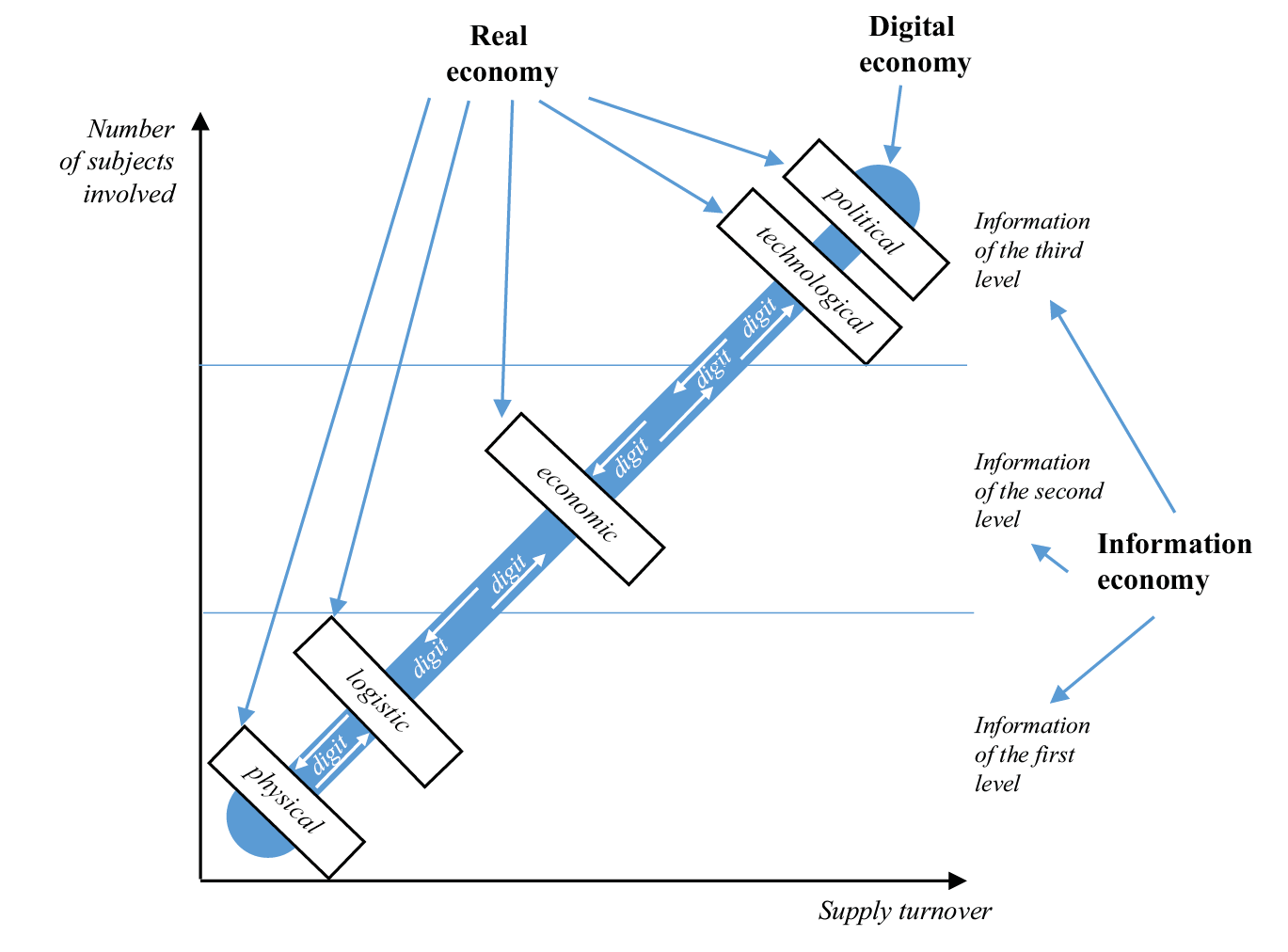
The source: compiled by the authors.
Fig. 2. Model of transportation growth with a limited increase in the number of actors involved (conservative strategy)
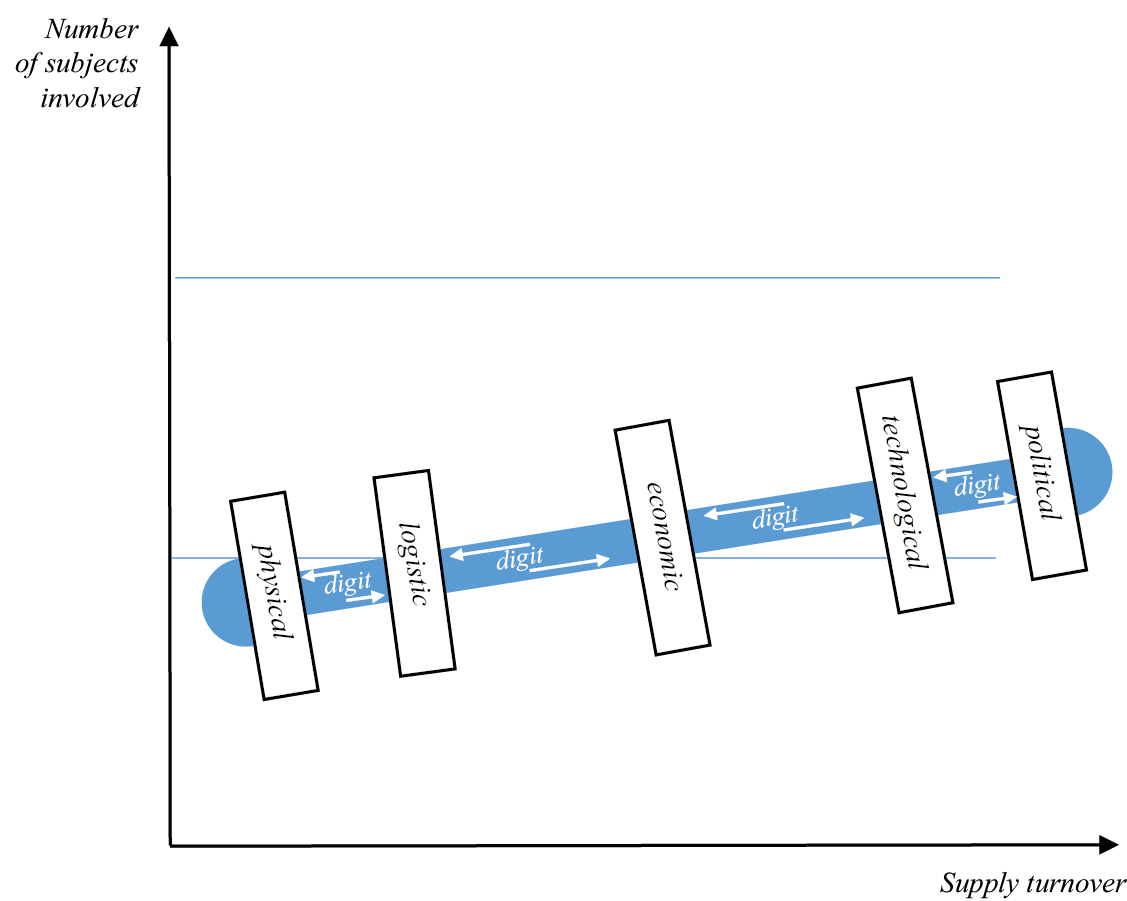
The source: compiled by the authors.
Fig. 3. The model of growth of the number of the involved subjects with the invariable volume of transportation (transactional strategy)
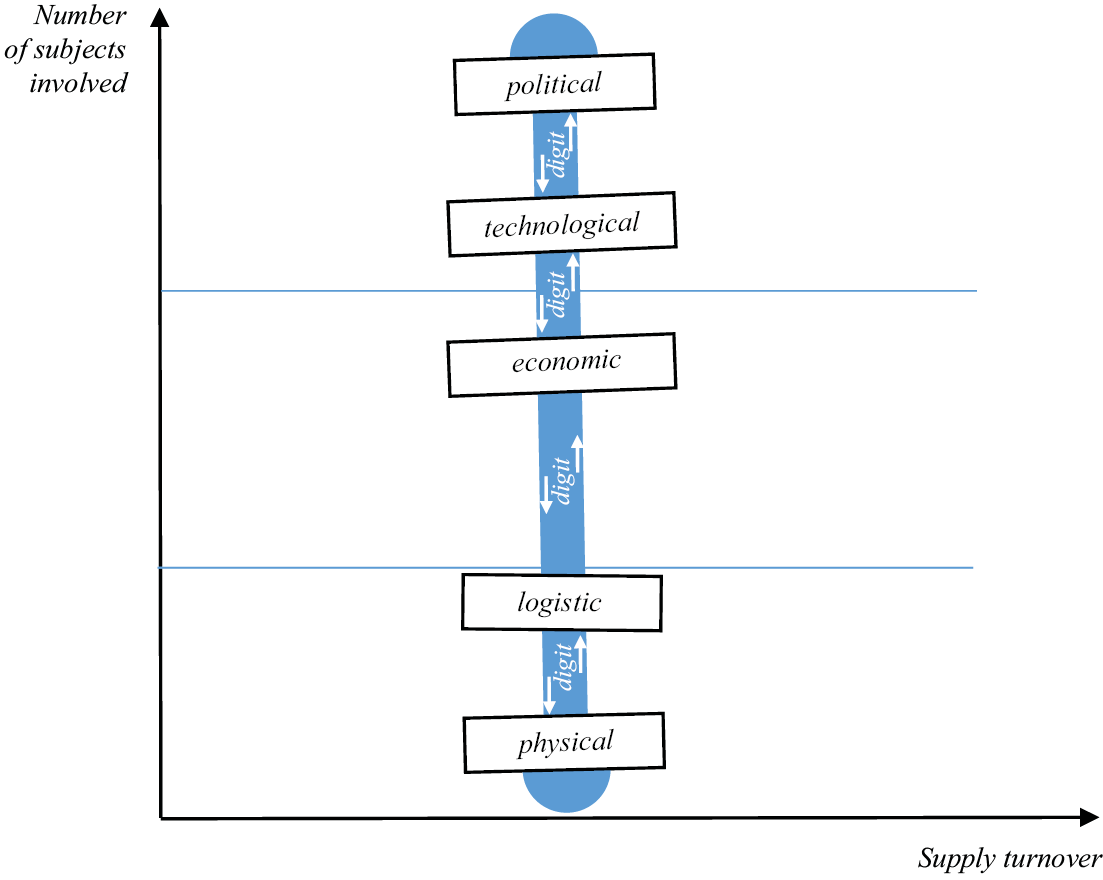
The source: compiled by the authors.
Table 1
Parameters of railway transport activity
|
Indicator |
2005 |
2010 |
2015 |
2017 |
2018 |
2019 |
|
Length of communication lines (thousand km) |
… |
124 |
118 |
123 |
122 |
122 |
|
Working fleet of loaded railway cars (thousand pieces on average per day) |
270 |
328 |
388 |
417 |
461 |
473 |
|
Operating length of railway tracks (thousand km) |
85 |
86 |
86 |
87 |
87 |
87 |
|
Density of public railway tracks (km per 1000 km2 of the territory) |
5.0 |
5.0 |
5.0 |
5.1 |
5.1 |
5.1 |
|
Intensity of cargo transportation per 1 km of the length of public railways |
21.8 |
23.5 |
26.7 |
28.8 |
30.0 |
29.9 |
|
Working fleet of loaded railway cars (thousand pieces on average per day) |
270 |
328 |
388 |
417 |
461 |
473 |
|
Freight transported (million tons) |
1273 |
1312 |
1329 |
1384 |
1411 |
1399 |
|
Number of railway accidents |
5 |
1 |
15 |
14 |
10 |
18 |
-
ASSESSMENT OF INFORMATION LEVELS
Testing the model shown in Fig. 1 requires internal, specially collected information about the activities of a transport company. Due to the lack of such information in the public domain, publicly available information on the activities of freight rail transport in Russia (mainly data from the State Statistics Committee of Russia) will be used, which makes it possible to judge the digital twin as a first approximation despite the fact it characterizes its activities only indirectly.
Taking into account this fundamental reservation, we will consider all three information levels and try to model the digital twin of Russian railway transport in a binary, digital representation.
6.1. THE FIRST-LEVEL INFORMATION
If we assume that А is the set of actions available to the carrier (regardless of whether he acts in his own interests or in the interests of others), then in this set there is some subset of actions В (В ⊂ А), in which the carrier can connect factors of production for the implementation of the transportation process.
In turn, in this subset В there are several alternative algorithms for connecting factors of production (that is, subsets of the third level, for example, two alternative subset algorithms C and D): from randomly spontaneous to verified in detail. These algorithms differ in the information that underlies them. Each carrier is able to rank these algorithms from best to worst, for example, cargo transportation algorithm C is more productive than algorithm D: C > D, since it brings greater physical results from transportation (RC).
Having chosen the best algorithm, the carrier adheres to it in the future, resulting in a process that Bogdanov called progressive selection [Bogdanov, 1989. p. 202], which manifests itself in the spontaneous consolidation of those actions that improve the technological process. In other words, the carrier improves the algorithm and the consequence of this "is an increase in its activities due to the environment" [Bogdanov, 1989. p. 202]. On the external plane, this manifests itself in a decrease in the number of unproductive actions, as well as losses in time and working capital, which is generally equivalent to an increase in the physical results of the transportation process from optimizing the same algorithm:
RC1 > RC2 > … > RCn. (1)
The efficiency of a transport enterprise in modeling the transportation process is evidenced by the first-level information (applied technology), which should reduce the labor intensity and energy intensity of cargo transportation, reduce transportation time, save rolling stock and track, provide shippers with physical access to increasingly remote areas, etc.
As you can see, in 2019, compared to 2005, there is a significant increase in the performance of railway transport, which positively characterizes the use of practical technologies. An exception is the increase in the number of accidents, which may indicate a weakening control over transportation technology.
On the whole, it can be stated that inequality (1) is satisfied, which means that the railway transport of Russia as a whole works effectively with the information of the first level.
6.2. THE SECOND-LEVEL INFORMATION
The second-level information of the digital twin should show how effectively transport companies can predict the behavior of their transportation partners, that is, synchronize their activities with those of the main consignors and consignees.
If А is the set of possible actions of railway transport, and H is the set of possible actions of consignors, then the subset of jointly performed actions G (Fig. 4, a) increases over time (Fig. 4, b) due to the accumulation of experience, synchronization of their activities and reduction of transaction costs.
Moreover, with the deepening of the division of labor, subsets of the action E and F, become available to them, which were previously inaccessible (Fig. 4, c). This can manifest itself, for example, in the sharing of rolling stock, infrastructure, training centers, etc.
To analyze such processes, it would be advisable to compare the following indicators (which are equally applicable for both the carrier and its partners): the rhythm of the main activity, the level of utilization of fixed assets, the duration of the main production cycles, etc. However, given the publicly available information on the adaptation of the carrier's activities to the activity of its partners (for example, coal mining companies), one can judge indirectly: by the surplus/deficit of cars and the dynamics of production of the main shippers (Fig. 5).
As can be seen from the figure, for the period under review, the dynamics of coal production is in antiphase with respect to the deficit / surplus of cars for its transportation. Meanwhile, hard coal is key for rail transport: it accounts for about a third of the total volume of loading. The same applies to the dynamics of mining of metal ores. This situation has many reasons: from the inelastic supply of railcars and the length of the investment cycle for the renewal of the railcar fleet to the volatility of demand for freight transportation services.
This means that at the second-level information, the activities of railway companies are not sufficiently synchronized with their main partners (at least in the medium term).
6.3. THE THIRD-LEVEL INFORMATION
The efficiency of a transport enterprise at the third level of information means that it is able to influence other participants in the transportation process, using new technologies and political levers, as well as to harmonize relations with them in the long term. The consequence of this should be the harmonization of their long-term interests and the effectiveness of the main production activities. Of fundamental importance is the emergence of tools for managing the activities of consignors which leads to the set of their possible actions H that become a subset of actions of railway transport А (Fig. 6, b). In other words, shippers become a subsystem of rail transport (H ⊂ А).
With the available information, the situation in Fig. 6 can only be assessed indirectly – through a comparison of the profitability or effectiveness of their activities (Table 2).
From Table. 2, we can conclude that the profitability of the main production activities of shippers (enterprises for the extraction of coal, gas, oil and ores) is several times higher than the profitability of the main production activities of railway carriers. Of course, each of these industries has its own market, degree of price control, level of monopolization and taxation, and so on. Nevertheless, rail transport demonstrates less investment attractiveness, insufficient control over the cost of transportation and the economic efficiency of new technologies. Of high importance is the regulatory function of the state which directly and indirectly limits the amount of tariffs. However, the rail freight market is a buyer's (i.e. shipper's) market.
At the same time, in terms of return on assets, rail transport is an absolute leader among those industries presented in
Table. 2, which can be explained by the relatively smaller size of such assets in monetary terms.
As a result of this analysis, an image of a digital twin for the railway transport of Russia is formed (Fig. 7).
The right side of Fig. 7 (b) is nothing more than a digital twin of the enterprise, composed of all three types of the information, which provides new instrumental capabilities. Thanks to it, for example, it is possible to judge with greater or lesser accuracy the real economy of the carrier, as well as the efficiency of his work with information.
The image can be different: from that shown in Fig. 5 as generalized as possible to reveale the work of individual divisions of the transport enterprise.
Fig. 4. Effect of synchronization of railway transport and shippers activities
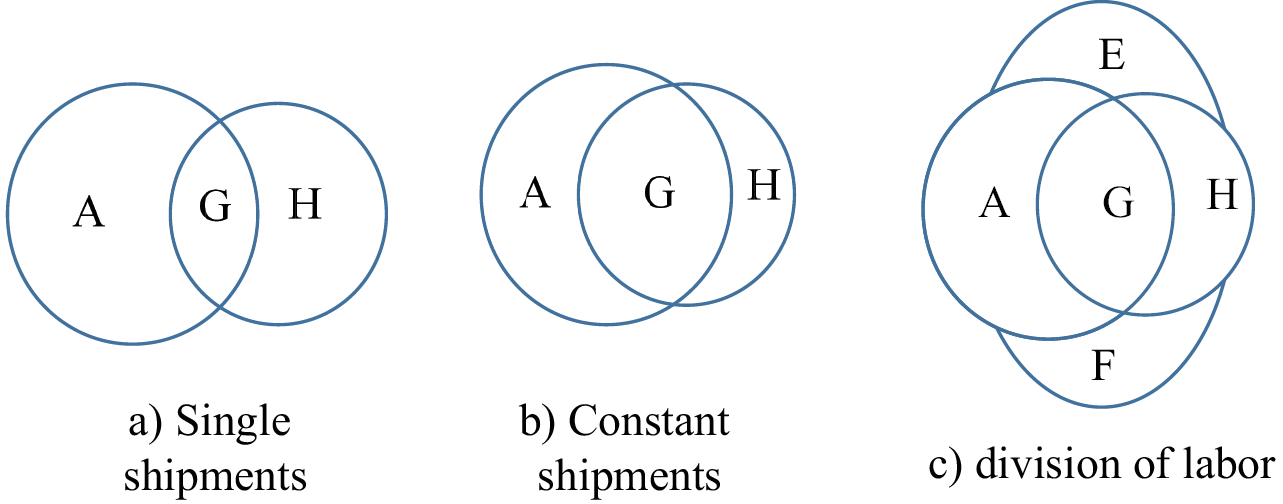
The source: compiled by the authors.
Fig. 5. Surplus/deficit of cars and dynamics of the main cargo shippers' production
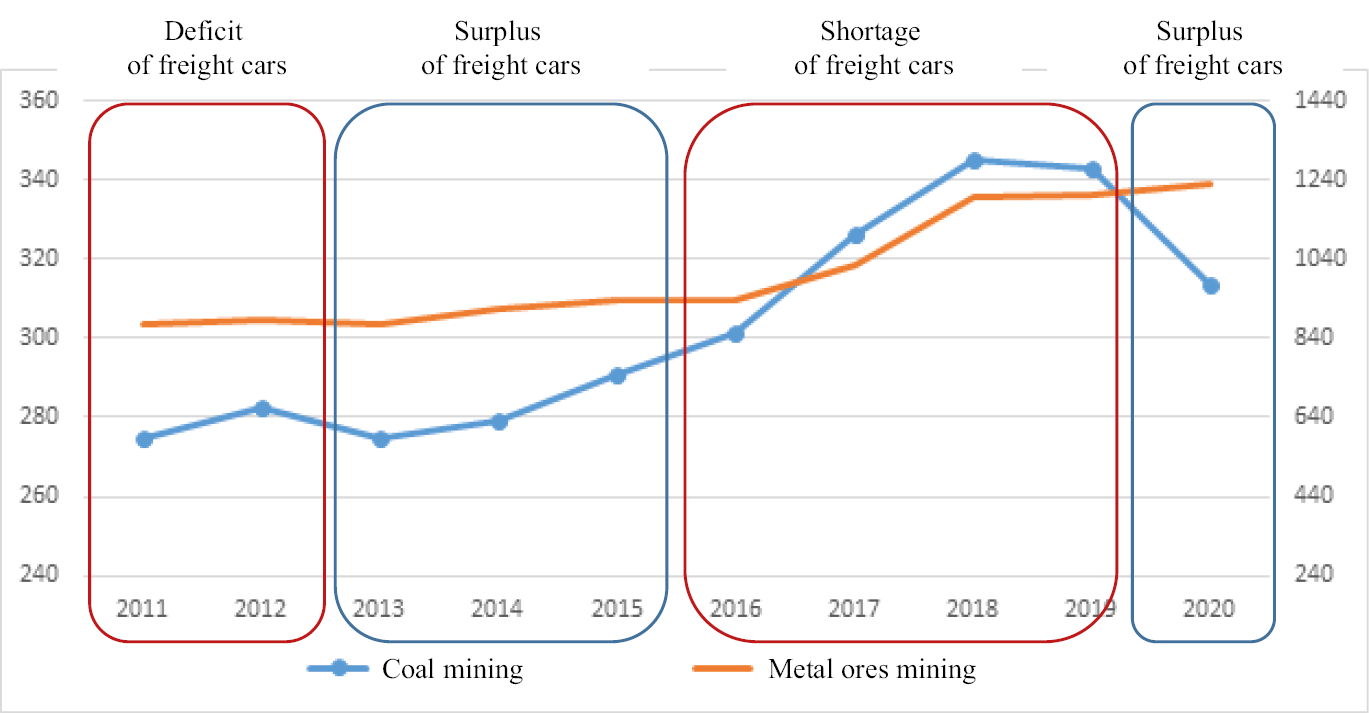
Sources: Russia in numbers. 2019: Brief stat. Sat. M.: Rosstat, 2019; [Savchuk, 2020].
Fig. 6. Management of cargo shippers activity thanks to the information of the third level of the railway transport
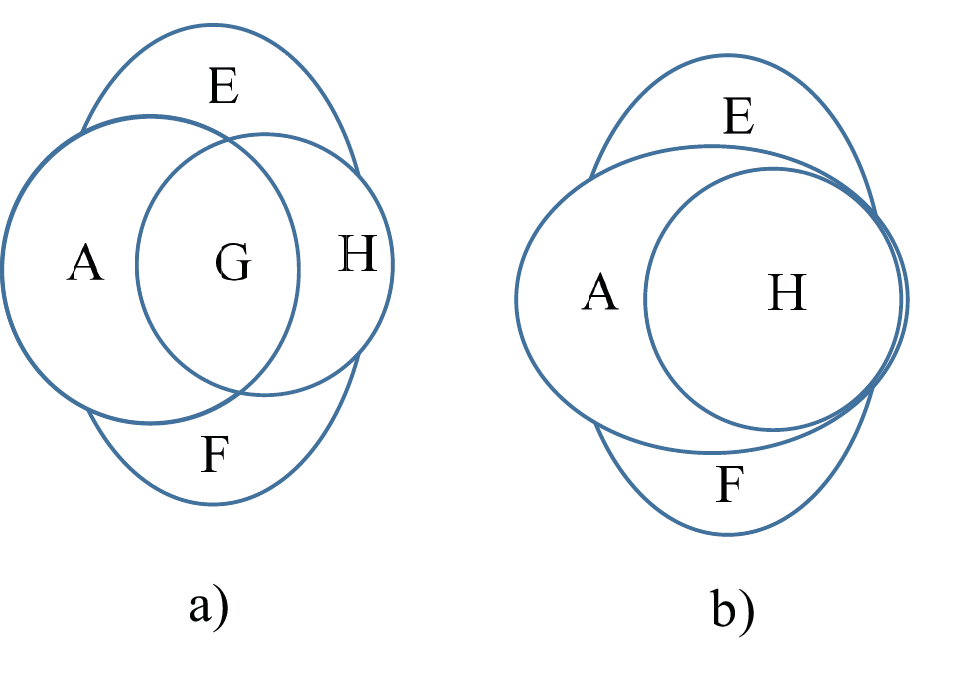
The sources: compiled by the authors.
Fig. 7. Image of digital twin for Russian railway transport
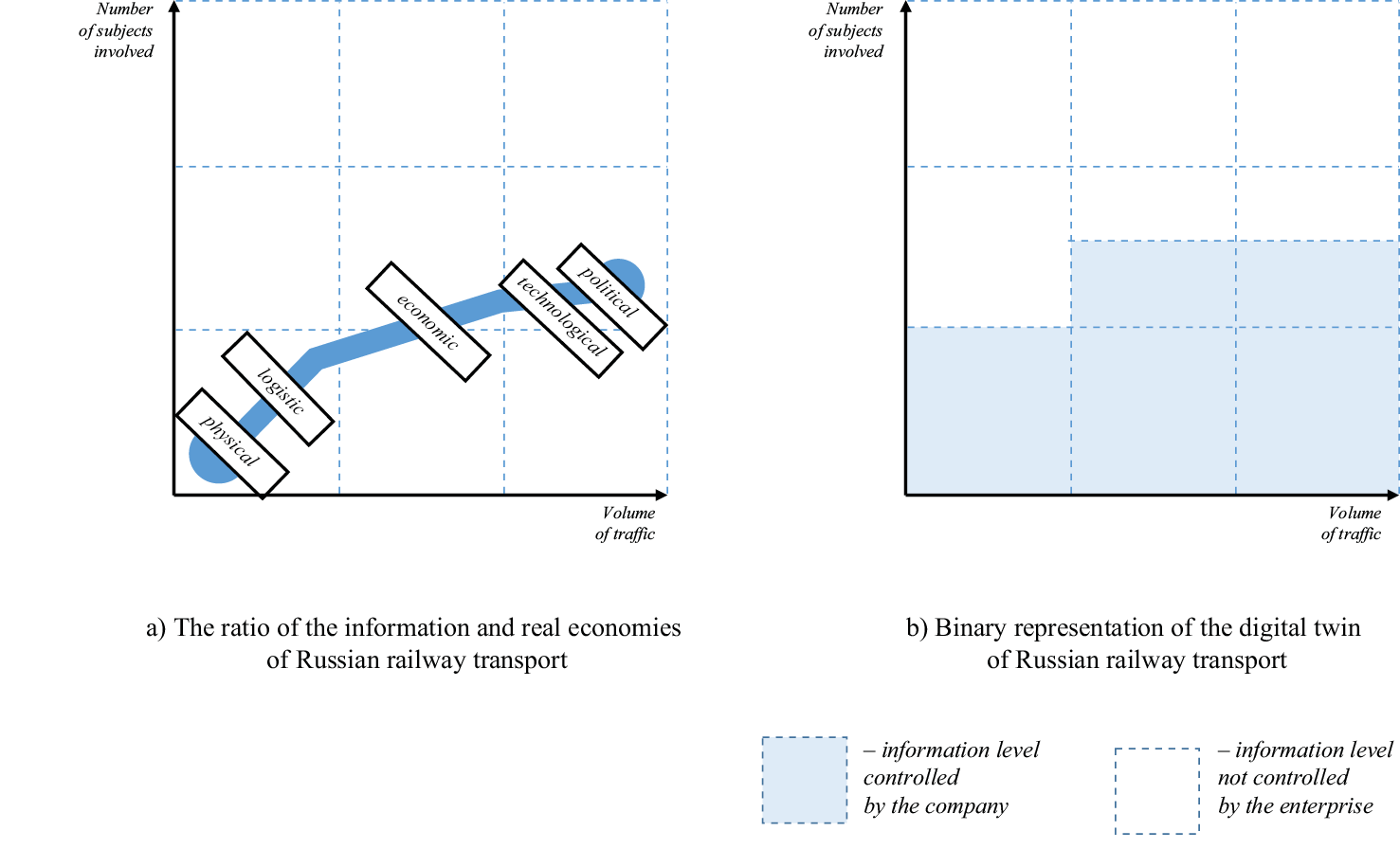
The source: compiled by the authors.
Table 2
Profitability of sold goods, products (works, services) and assets of organizations by types of economic activity (%), 2017–2018
|
Indicator |
2017 |
2018 |
||
|
Profitability of sold goods, products (works, services) |
Profitability |
Profitability of sold goods, products (works, services) |
Profitability |
|
|
Total |
6.7 |
3.8 |
12.3 |
6.4 |
|
Extraction of minerals, including: |
24.6 |
10.4 |
33.6 |
17.3 |
|
Coal minig |
28.4 |
16.1 |
31.4 |
11.6 |
|
Crude oil and natural gas production |
24.1 |
10.7 |
35.3 |
20.4 |
|
Mining of metal ores |
47.4 |
11.3 |
57.3 |
17.6 |
|
Extraction of other minerals |
41.5 |
7.8 |
50.9 |
7.6 |
|
Railway transport activity: |
13.6 |
16.7 |
18.5 |
20.2 |
-
DISCUSSION AND CONCLUSION
Information today is a key factor in the economy as a resource, a commodity, a source of added value and a means of employment. The advent of the Internet, the reduction in the cost of access to the global network, the multiplication of computing abilities have become a real digital revolution that has changed our life in general and the economy in particular.
Digitalization has become the most important factor in the activity of all sectors of the economy, including transport. It is clear that modern transport and logistics will require a different management approach that not only takes into account technological aspects, but is also more customer-oriented than ever before. This forms the prerequisites for creating a digital service of the 21st century, a customer-oriented economy on demand in a digital reality.
This is quite clearly realized by both the leaders of transport companies and government officials. Thus, the government decree dated from March 19, 2019 No. 466-r4 approved the long-term development program of Russian Railways JSC until 2025, which involves the implementation of the Digital Railway project, including:
- Creation of a unified information space for freight traffic and the passenger complex;
- Formation of end-to-end digital technologies for organizing the transportation process in order to improve the efficiency of rail transportation and infrastructure;
- Creation of a unified integrated automated management system, optimization of corporate enterprise management systems, analysis and development of reporting.
By virtue of large-scale digitalization, the presence of a digital twin becomes an integral part of every transport enterprise. This requires clarification of the quantitative relationships between the three levels of information, which allows to calculate automatically all other parameters of the analyzed transport enterprise in case you know one numerical parameter. This issue deserves separate consideration in subsequent articles.
The rapid growth of the importance of the digital twin has obvious disadvantages. So, today we see, for example, that with the accumulation of information capacity, scientometric, abstract bases become almost more important than scientific articles and journals themselves, the collected data on people's consumer behavior is more important than each individual, and the ability to generate more and more new digital money is important in comparison to the state of the real economy.
The next stage of digitalization may be the autonomy of individual modules of the digital economy, that is, their ability to initiate and interact with each other while activating certain physical production processes. It is likely that on the basis of the third level information it will be possible to create new first-level information without the direct participation of a person (that is, to invent), as well as to perform legally significant actions (for example, order a transportation service).
1 Decree of the President of the Russian Federation of May 9, 2017 No. 203 “On the Strategy for the Development of the Information Society in the Russian Federation for 2017–2030”. URL: http://kremlin.ru/acts/bank/41919.
2 World Bank Review "Digital Dividends" (2016). URL: https://openknowledge.worldbank.org/bitstream/handle/10986/23347/210671RuSum.pdf.
3 An example of such an ideal system in some cases can be a river (for passing carriers). In the modern economy, they are trying to get closer to this state, for example, by creating unmanned vehicles.
4 Decree of the Government of the Russian Federation from March 19, 2019 No. 466-r “On Approval of the Development Program of Russian Railways JSC until 2025”. URL: http://www.consultant.ru/document/cons_doc_LAW_320741/.
References
1. Bogdanov A.A. (1989). Tectology (General Organizational Science), book 1. Moscow, Ekonomika. (In Russ.)
2. Katasonov V.Y. (2019). At the beginning there was a Word, and at the end there will be a figure: Articles and essays. Moscow, Kislorod. (In Russ.)
3. Mazo L.A., Miroshnichenko O.F., Efimova E.N. (2021). The history and modernity of the railway transport economy in the works of VNIIZHT scientists. Vestnik VNIIZhT, 80(3): 168-181. https://doi.org/10.21780/2223-9731-2021-80-3-168-181. (In Russ.)
4. Savchuk V.B. (2020). Railway rolling stock 2020: Status and prospects. URL: http://www.ipem.ru/files/files/research/20200424_rolling_stock_2020.pdf. (In Russ.)
5. Shchedrovitsky P.G., Kuznetsov Y.V. (2016). Adam Smith on the division of labor. Questions of Philosophy, 5: 27-38. (In Russ.)
6. Banalieva E., Dhanaraj Ch. (2019). Internalization theory for the digital economy. Journal of International Business Studies, 50: 1372-1387. URL: https://doi.org/10.1057/s41267-019-00243-7. (In Russ.)
7. Barbosa J., Leitão P., Trentesaux D., Colombo A.W., Karnouskos S. (2016). Cross benefits from cyber-physical systems and intelligent products for future smart industries. 14th IEEE International Conference on Industrial Informatics. Poitiers, France, 504-509.
8. Brennen S., Kreiss D. (2016). Digitalization. The International Encyclopedia of Communication Theory and Philosophy, 1-11.
9. Brouthers K., Geisser K., Rothlauf F. (2016). Explaining the internationalization of ibusiness firms. Journal of International Business Studies, 47(5): 513-534.
10. Dahlman C., Mealy S., Wermelinger M. (2016). Harnessing the digital economy for developing countries. Paris, OECD.
11. Daviesa A., Donaldb B., Grayc M., Knox-Hayesd J. (2017). Sharing economies: Moving beyond binaries in a digital age. Cambridge Journal of Regions. Economy and Society, 10: 209-230. DOI:10.1093/cjres/rsx005.
12. Engel J.S. (2015). Global clusters of innovation. California Management Review, 57(2): 36.
13. Foster Ch., Azmeh Sh. (2020). Latecomer economies and national digital policy: An industrial policy perspective. The Journal of Development Studies, 56(7): 1247-1262. DOI: 10.1080/00220388.2019.1677886.
14. Grieves M. (2017). Digital twin: Manufacturing excellence through virtual factory replication. Florida Institute of Technology, 24.
15. Kling R., Lamb R. (2000). IT and organizational change in digital economies. In Understanding the Digital Economy; MIT Press: Cambridge, MA, USA, 295-324.
16. Kuchinke B.A. (2016). Vidal M. Exclusionary strategies and the rise of winner-takes-it-all markets on the Internet. Telecommunications Policy, 40(6): 582-592.
17. Sampath P.G. (2018). Promoting transformation in the digital economy. Global Development and Environment Institute Working Paper, 18-04: 26.
18. Srnicek N. (2016). Platform capitalism. Cambridge, UK: Polity Press.
19. Weber S. (2017). Data, development and growth. Business and Politics, 19(3): 1-27.
20. Zhu F., Iansiti M. (2012). Entry into platform-based markets. Strategic Management Journal, 33(1): 88-106.
About the Authors
O. N. RimskayaRussian Federation
Candidate of economic sciences, associate professor, head of the Scientific and Educational Complex of the Research Institute of Railway Transport (Moscow, Russian Federation). ORCID 0000-0002-1548-0815, Researcher ID 583440, SPIN: 4185-4532, AuthorID: 583440. Research interests: world economy, digital economy, labor economics, education economics, lifelong education, European systems and models of education, human resource management, motivation and stimulation of labor, economic and political problems of the humanitarian crisis.
I. V. Anokhov
Russian Federation
Candidate of economic sciences, associate professor, chief-editor of the Scientific and Publishing Department of the Research Institute of Railway Transport (Moscow, Russian Federation). ORCID: 0000-0002-5983-2982, Researcher ID: AAF 9428 2020, SPIN: 1444-3259, AuthorID: 260787. Research interests: labor, economic interests, theory of firms, transport.
Review
For citations:
Rimskaya O.N., Anokhov I.V. DIGITAL TWINS AND THEIR APPLIANCE IN TRANSPORT ECONOMICS. Strategic decisions and risk management. 2021;12(2):127-137. https://doi.org/10.17747/2618-947X-2021-2-127-137









































